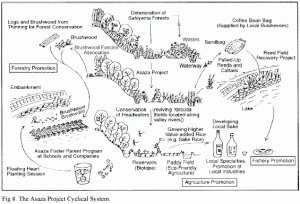Front-page (封面):
Environmental Conservation and Internally-Inspired Development
环境保护和内部激励的发展
“ASAZA Project”-Strategy for Establishment of a Sustainable Society in the Lake Kasumigaura Catchment Basin
ASAZA 项目-在霞浦湖领域建设可持续型社会的战略
Great Reed Warbler 大苇莺 Little Grebe 角
Whooper Swan 天鹅 Cuckoo 布谷鸟
Bean Goose 豆雁 White Stork 白鹳
Crane 鹤 Japanese Crested Ibis 朱鹮
In 10 (20, 30, 40, 50, 100) years 10 (20,30,40,50,100)年内
Spread of reed fields 芦苇田的展开
The shore lined with willow trees 湖岸边的柳树带
The spread of a lush vegetation zone 茂盛植物区域的展开
Forest 森林 Paddy field 稻田
Reservoir 贮水池 Lake 湖
Looking ahead to the coexistence of nature and humankind in the 22nd century
22世纪人类与自然共存的展望
Nonprofit Organization ASAZA Fund 非盈利组织 ASAZA基金会
Back page (封底)
In 1000 years 1000年内 Kappa 河童
Lake Kasumigaura Revival Project 霞浦湖复苏项目
Uniting Lakes, Forest, and People 湖泊,森林与人的共存
非盈利组织ASAZA基金会
〒300-1233日本国茨城县牛久市荣町6-387
电话: 0081-29-871-7166
传真: 0081-29-871-7169
E-mail: asaza@jcom.home.ne.jp(English Or Japanese Only)
Fig 1. Distribution and profile of lake Kasumigaura
霞浦湖的地理位置及其轮廓
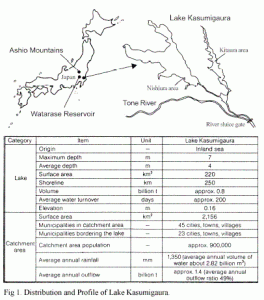
Ashio Mountains 足尾山 Lake Kasumigaura 霞浦湖
Kitaura area 北浦 Nishiura area 西浦
Watarase Reservoir 渡良濑 Tone River 利根河
River sluice gate 水闸
Category 种类 Item 项目 Unit 单位
Lake 湖 Catchment area 集水区域
Origin 起源 Inland sea 内陆海
Maximum depth 最大深度 Average depth 平均深度
Surface area 表面积 Shoreline 水岸线
Volume 容量 Average water turnover 平均湖水更新
Elevation 海拔 Municipalities in catchment area 流域城镇
Municipalities bordering the lake 湖滨城镇
Catchment area population 流域人口
Average annual rainfall 平均年降水量
Average annual outflow 平均年失水量
Billion t 10亿吨 Approx 约 cities,towns,villages 市镇村
(Average annual volume of water about 2.82 billion m3)
平均年降水量为28.2亿立方米
(Average annual outflow ratio 49%)
平均年失水率为49%
Fig 2. Change of the Lake Kasumigaura shoreline
霞浦湖湖岸线的变化
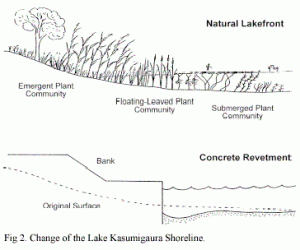
Natural lakefront 天然的湖岸 Concrete Revetment 混凝土堤岸
Emergent plant community 自然植物群落
Floating-leaved plant community 浮游植物群落
Submerged plant community 水生植物群落
Bank 湖堤 Original surface 原始土表
Fig 3. The liaison flowchart of public works by community members
社区成员公共事业的联系流程
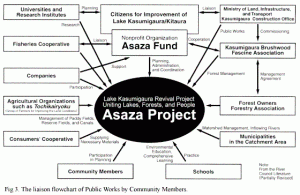
Universities and research institute 大学和研究所
Fisheries cooperative 渔业协会 Companies 企业
Agricultural Organization such as To chi ka i ryo ku (Group of farmers for improving the land condition)
农业组织如土地改良农民团体
Consumers’ cooperative 消费者协会 Community members 社区成员
Schools 小学校 Municipalities in the catchment area 流域所辖城镇
Forest owners Forestry Association 森林拥有者林业协会
Kasumigaura brushwood fascine association 霞浦湖杂木采集协会
Ministry of land, infrastructure and transport Kasumigaura construction office
国土交通厅霞浦湖建设办公室
Citizens for improvement of lake Kasumgaura/kitaura 致力于霞浦湖/北浦改良的市民
Planning 计划 Liaison 联系 Cooperation 合作
Public works 公共事业 commissioning 代理 support 支持
Planning, administration and coordination 计划,管理和协调
Forest management 森林管理 Management agreement 管理协议
Management of paddy fields, reservoirs fields, and canals
稻田,贮水池区域和运河管理
Supplying necessary materials 提供必需物资
Participation in planning 参与计划
Environmental education, comprehensive learning 环境教育,综合学习
Practice 实践
watershed management, inflowing rivers 湿地管理,流入河流
Fig 4. Floating Heart Community Recovers Sand Beach
杏菜(ASAZA)群落恢复沙地
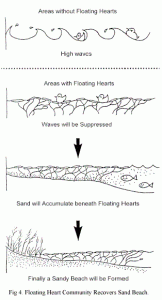
Areas without floating heart 无杏菜(ASAZA)区 High waves 大浪
Areas with floating heart 杏菜(ASAZA)区
Waves will be suppressed 波浪被缓冲
Sand will accumulate beneath floating heart 杏菜(ASAZA)下沙子聚集
Finally a sandy beach will be formed 最后形成沙地
Fig 5. ASAZA Foster parent program
ASAZA(杏菜)培育流程
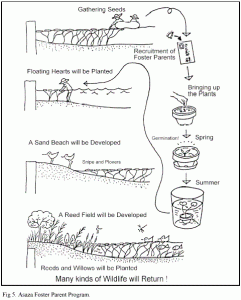
Gathering seeds 采集种子 Recruitment of Foster Parent 培育者的募集
Bringing up the plants 播种 Germination 萌芽
Spring 春天 Summer 夏天
Floating Hearts will be planted 种植ASAZA(杏菜)
A sand beach will be developed 沙滩的形成
Snipe and Plovers 沙锥鸟和水喜鹊
A reed field will be developed 芦苇丛的形成
Reeds and willows will be planted 种植芦苇和柳树
Many kinds of wildlife will return 多种野生生物的复归
Fig 6. Restoring the diverse plant community along the lakeshore
湖滨多种植物群落的恢复
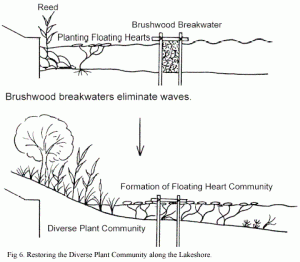
Reed 芦苇 Brushwood breakwater 杂木防波堤
Planting Floating Heart 种植杏菜
Brushwood breakwaters eliminate waves 杂木防波堤缓冲波浪
Formation of Floating Heart Community 杏菜(ASAZA)群落的形成
Diverse Plant Community 多种植物群落
Fig 7. Forest conservation linking the lake-reviving project
与湖泊复苏项目关联的森林保护
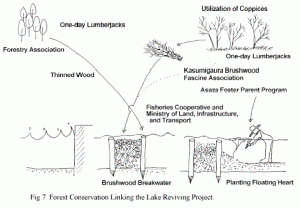
One-day lumberjacks 一日伐木工人 Forestry Association 林业协会
Thinned wood 间伐材 Utilization of coppices 矮丛林利用
Kasumigaura Brushwood Fascine Association 霞浦湖杂木采集协会
ASAZA Foster Parent program ASAZA培育项目
Fisheries Cooperative and Ministry of Land, Infrastructure, and Transport
渔业协会和国土交通部
Brushwood Breakwater 杂木防波堤 Planting Floating Heart 种植杏菜
Fig 8. The ASAZA Project Cyclical System
ASAZA项目循环系统
Logs and Brushwood from Thinning for Forest Conservation
森林保护间伐得到的圆木和杂木
Brushwood 杂木 Brushwood Fascine Association 杂木采集协会
Forestry Promotion 林业推广 Embankment 防护堤
Brushwood Breakwater 杂木防波堤
ASAZA Foster Parent Program at schools and companies
学校和企业中的ASAZA培育项目
Floating Heart Planting Session ASAZA(杏菜)种植活动
Deterioration of Satoyama Forest 村落山林的恶化 Wastes 废弃
ASAZA Project ASAZA项目
Conservation of headwaters (reviving Yatsuda [fields located along valley rivers])
水源保护(谷津田〖位于河谷的土地〗复苏)
Growing higher value-added rice (e.g. Sake Rice) 种植高附加值大米 (如酒米)
Reservoirs (Biotope) 水库(生态场所)
Paddy field (Eco-friendly Agriculture) 稻田(生态农业)
Coffee Bean Bag (Supplied by local businesses) 咖啡豆包(当地企业提供)
Sand bag 沙包 Waterway 水道
Pulled-up Reeds and Cattails 芦苇和猫尾草的生长
Reed field recovery project 芦苇田的恢复计划
Lake 湖 Developing Local Sake 发展当地酒业
Local specialties, promotion of local industries 当地特产,并促进当地产业发展
Agriculture Promotion 促进农业发展 Fishery Promotion 促进渔业发展
Fig 9. Previous lakesides survey by children
儿童调查的昔日湖畔景色
Fig 10. Planning and Restoration of the Vegetation Zone at Lake Kasumigaura by Community Members
社区成员进行霞浦湖植物生长区的规划和恢复
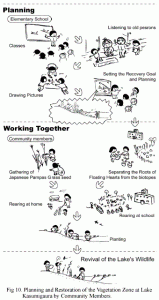
Planning 计划 Elemental School 小学校 Classes 班级
Listening to old persons 向老人调查 Drawing pictures 画图
Working Together 共同行动
Gathering of Japanese Pampas Grass Seed 芒草种子的收集
Separating the reeds of Floating Heart from the biotopes 把模拟生态场所的芦苇和杏菜(ASAZA)分开
Rearing at home 家中培养 Rearing at school 学校培养
Planting 种植 Revival of the Lake’s Wildlife 湖泊野生生物的复归
Fig 11. Monitoring the schools surrounding environment in the Biotope
在模拟生态场所调查学校周围环境

Who comes to our biotope? 什么会来到我们的模拟生态场所?
Reservoirs, Grassland 水库,草地 Forest, Reservoirs 森林,水库
Forest 森林 Paddy Field 稻田 Stream 溪流
Fig 12. Online Network with Local Schools and University/Research Institutions
当地学校和大学/研究所的在线网络系统

University 大学 Monitoring Data 调查数据 Database 数据库
High School 高中 Junior High School 初中
Elementary School 小学校 Kinder garden 友善花园
School Biotope Mailing List 学校模拟生态场所表
ASAZA Kids Website ASAZA 儿童(子)网站
ASAZA Fund Website ASAZA基金会网站
Fig 13. The Distribution of School Biotopes in the Lake Kasumigaura Basin
霞浦湖流域学校模拟生态场所的分布
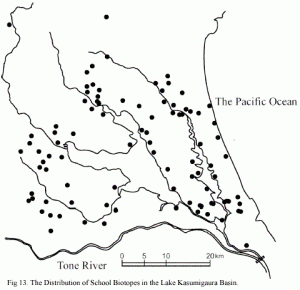
The Pacific Ocean 太平洋 Tone River 利根河
Fig 14. The Liaison of the Upstream and Downstream Regions by Utilizing Reeds
通过芦苇的利用将上游区域和下游区域联系起来
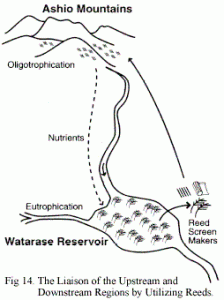
Ashio Mountains 足尾山 Oligotrophication 富营不良化
Nutrients 养分 Eutrophiation 富营养化
Reed Screen Makers 芦苇帘制造者
Fig 15. Watarase River Watershed Management under the Community/Public Coalition
社区/公共 联合下的渡良濑河湿地管理
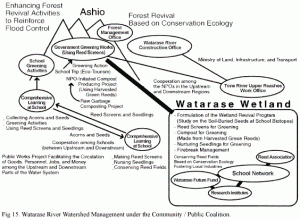
Ashio 足尾
Enhancing Forest Revival Activities to Reinforce Flood Control 扩展森林恢复活动到强化水灾控制
Forest Revival Based on Conversation Ecology 基于生态保护的森林恢复
Forest Management Office 森林管理办公室
Government Greening Works (Using Reed Screens) 政府绿化活动(用芦苇帘)
Watarase River Construction Office 渡良濑河建设办公室
School Greening Activities 学校绿化活动
Comprehensive Learning at School 在校综合学习
Tone River Upper Reaches Work Offices 利根河上游工作办公室
Ministry of Land, Infrastructure, and Transport 国土交通部
Greening Action School Trip (Eco-Tourism) 参观绿化行动学校 (生态游)
NPO-Initiated Compost Producing Project (Using Harvested Green Reeds)
非盈利组织主导的堆肥制造项目(利用收获的绿芦苇)
Raw Garbage Composting Project 生垃圾堆肥项目
Cooperation among the NPOs in the Upstream and Downstream Regions
上,下游区域非盈利组织的合作
Reed Screens and Seedlings 芦苇帘和幼苗
-Collecting Acorns and Seeds 采集橡子和种子
-Greening Activities Using Reed Screens and Seedlings 用芦苇帘和幼苗的绿化活动
Acorns and Seeds 橡子 和种子
Cooperation among Schools (Between Upstream and Downstream)
学校的合作(上游和下游)
Public Works Project facilitating the Circulation of Goods, Personnel, Jobs, and Money among the Upstream and Downstream parts of the Water System
公共事业项目促进水域系统上,下游间物资、人员、工作和资金的循环
-Making reed Screens 制造芦苇帘
-Nursing Seedlings 培育幼苗
-Conserving Reed Fields 保护芦苇田
Watarase Wetland 渡良濑湿地
-Formulation of the Wetland Revival Program (Study on the Soil-Buried Seeds at School Biotopes)
湿地复苏项目的构成(学校模拟生态系统土壤中埋的种子的研究)
-Reed Screen for Greening 绿化用芦苇帘
-Compost for Greening (Made from Harvested Green Reeds) 绿化堆肥(由收获的绿芦苇得来)
-Nurturing Seedlings for Greening 培育绿化用幼苗
-Firebreak Management 防火管理
Conserving reed Fields Based on Conservation Ecology Fostering Local Industries
基于生态保护的芦苇田维护培育了当地企业
Watarase Future Fund 渡良濑未来基金会 Reed Association 芦苇协会
School Network 学校网络 Research Institutes 研究机关








